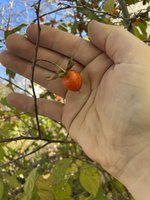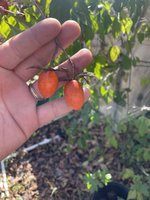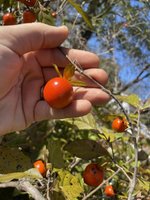TN_Jim
Omono
Diospyros virginiana fruit when ripe is amazing. It is so hard to find in the wild though because I think wildlife agree 
My first two fruit are growing nicely!!! This is a self-fruitful variety I got from Ed Clark. He ended up naming the variety "Beni Hime" (red princess).
View attachment 448601View attachment 448602View attachment 448603
You can take that up with him, that's what he told meIt would be smart to name it something else, or maybe 'Ed's Beni Hime' vel sim, to avoid confusion with the true 'Beni Hime' cultivar that has been around for decades.
But it also doesn't need a Japanese name... 'Ed's Red' works.
Not sure why, but some years some of my females skip fruiting - even though they are on the bench directly next to fruiting ones and receive the same care, sunshine, etc.
It is certainly a possibility. I thought all my females flowered at about the same time, but next spring I will keep track - and see if the dates correspond with fruiting (i.e. do the earlier or later flowering trees fruit more consistently?)Could it have to do with the synchronization with the flowering of male trees? i.e. some years your male(s) flower(s) and it coincides with some females, other years the same male(s) flower(s) and it coincides with other females?








My black ones are seven years from seed, no fruit so far! Obtained the seed from a vendor at Taikan Ten 2015 .Good growth after the first two or three years. Were slow to take off. Will see how they handle the move to my new location. I am going to start with higher level of nitrogen in the fertilizer regime this spring. basically they are now in 1 gallon pots. Here is a photo of the group this fall along the Northside of my greenhouse.I'd love to find a black one...

I don't know about cultivars, but the generic species did well in SoCal (zone 9b, with hot, dry summers) and are doing just as well in NC (zone 7b-8a, with warm, humid summers).How well does this species grow in the north central Texas climate (hot dry summers, relatively mild winters with occasional cold fronts)? Is there a difference in climate adaptation among different cultivars?
